Abstract
OBJECTIVES: This study tested the hypothesis that adoption and implementation of local policies regarding youth access to tobacco can affect adolescent smoking. METHODS: A randomized community trial was conducted in 14 Minnesota communities. Seven intervention communities participated in a 32-month community-organizing effort to mobilize citizens and activate the community. The goal was to change ordinances, merchant policies and practices, and enforcement practices to reduce youth access to tobacco. Outcome measures were derived from surveys of students before and after the intervention and from tobacco purchase attempts in all retail outlets in the communities. Data analyses used mixed-model regression to account for the clustering within communities and to adjust for covariates. RESULTS: Each intervention community passed a comprehensive youth access ordinance. Intervention communities showed less pronounced increases in adolescent daily smoking relative to control communities. Tobacco purchase success declined somewhat more in intervention than control communities during the study period, but this difference was not statistically significant. CONCLUSIONS: This study provides compelling evidence that policies designed to reduce youth access to tobacco can have a significant effect on adolescent smoking rates.
Full text
PDF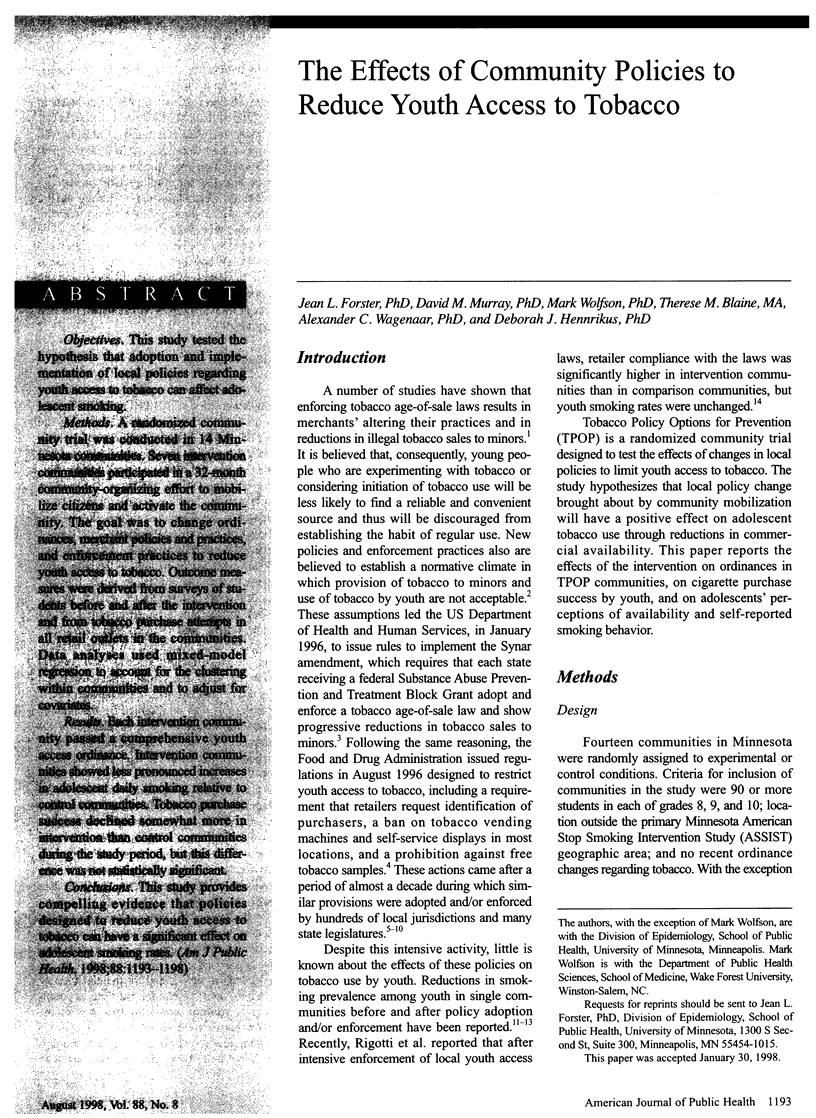
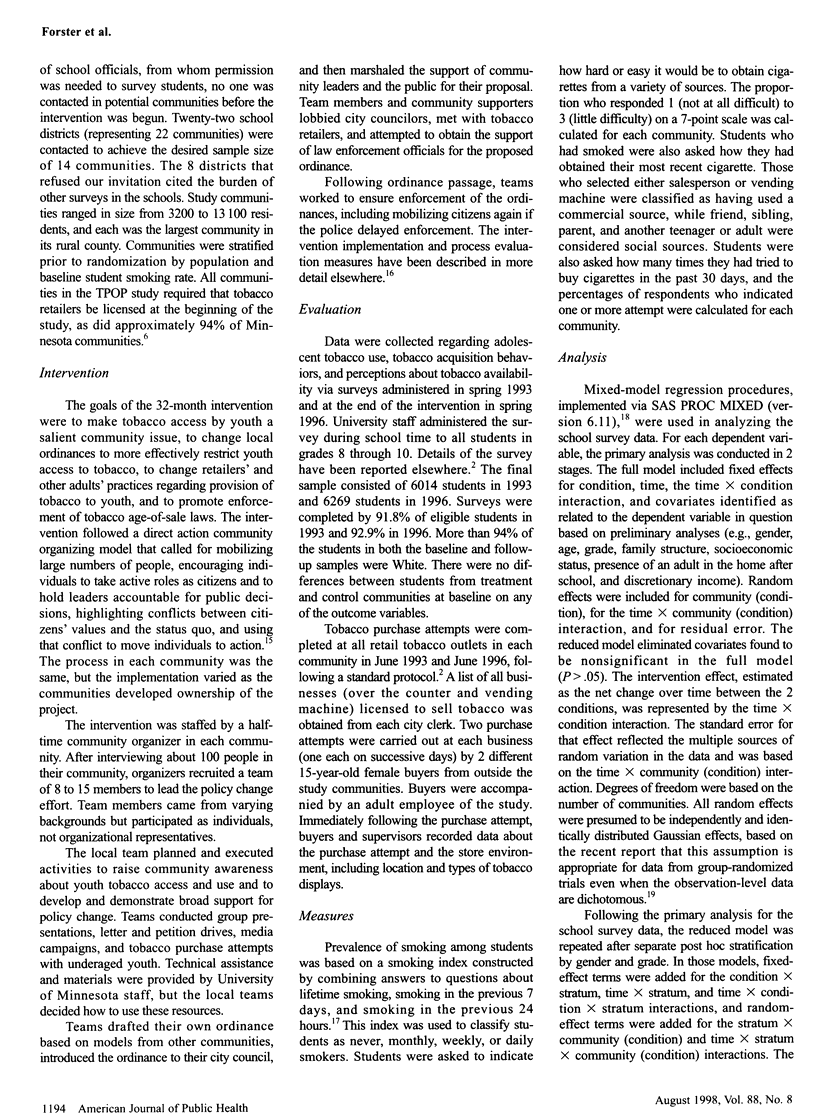
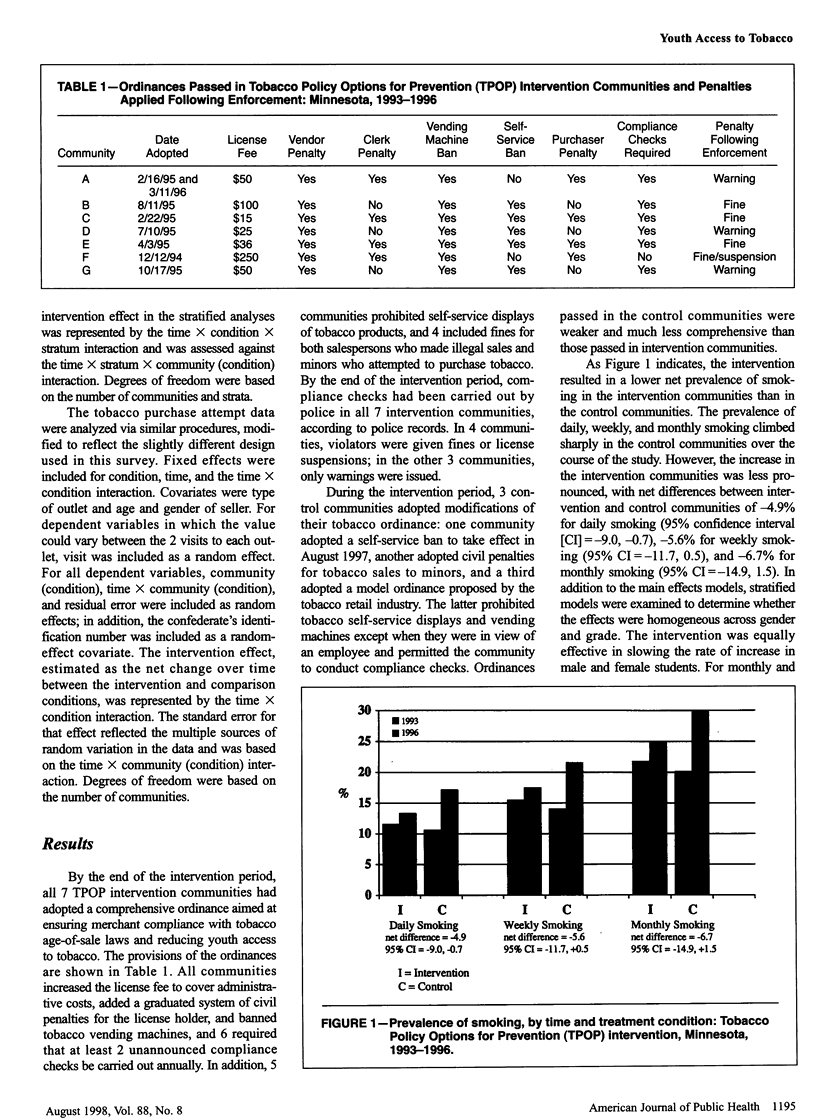
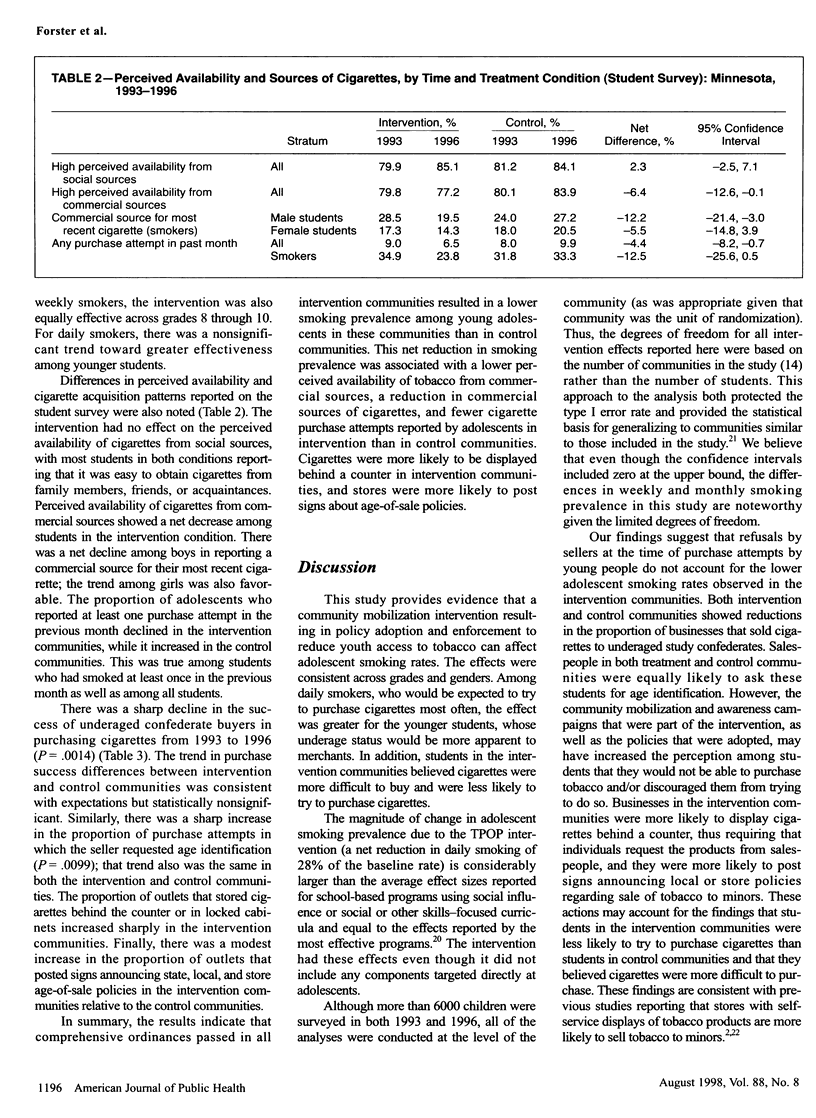
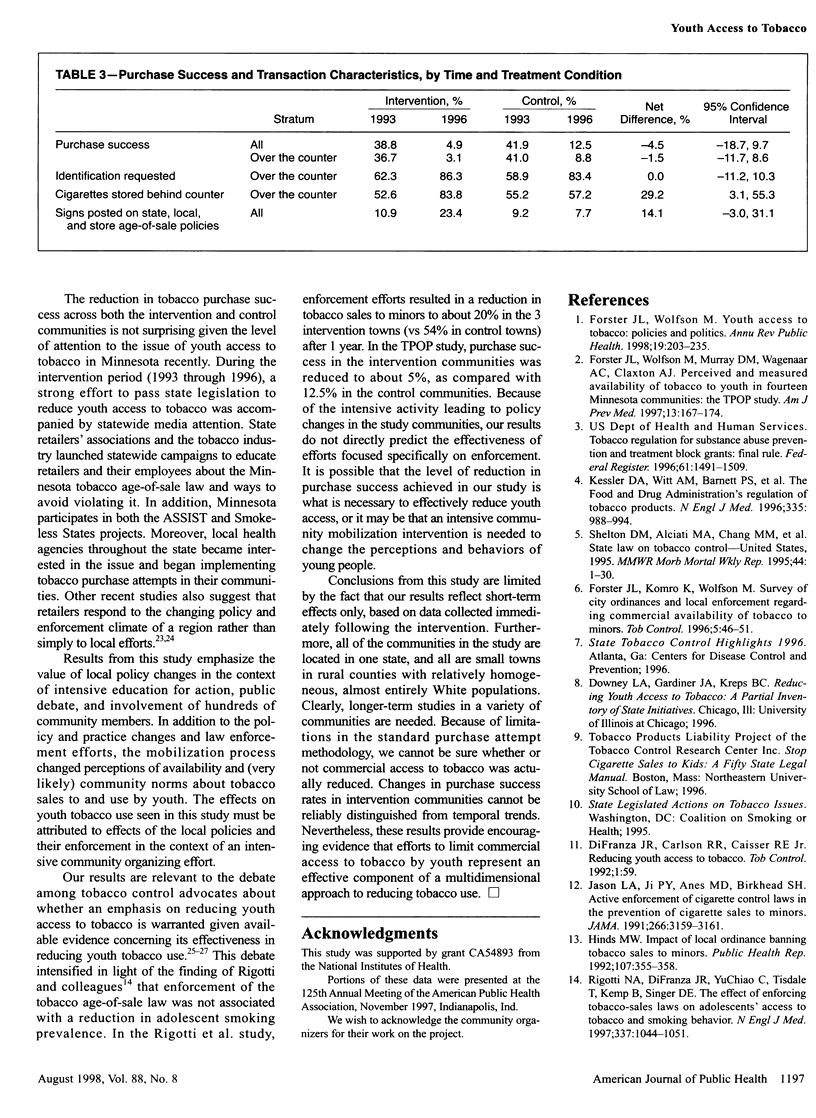
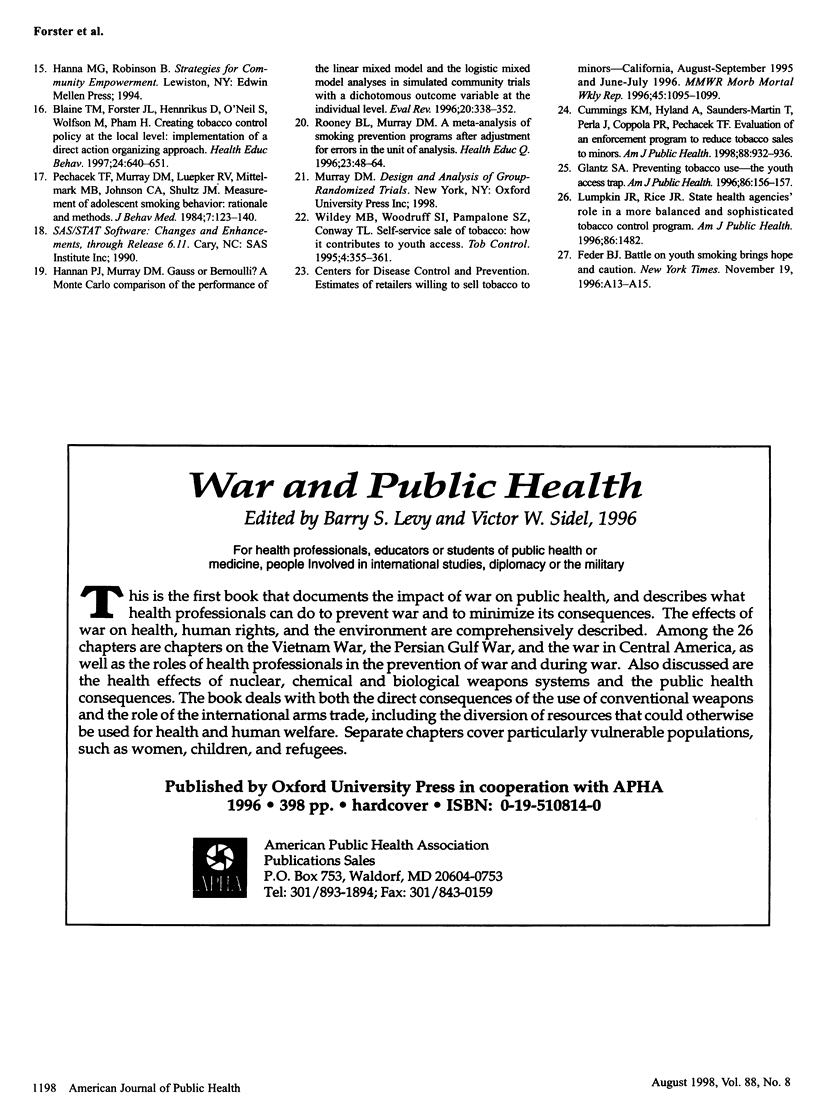
Selected References
These references are in PubMed. This may not be the complete list of references from this article.
- Blaine T. M., Forster J. L., Hennrikus D., O'Neil S., Wolfson M., Pham H. Creating tobacco control policy at the local level: implementation of a direct action organizing approach. Health Educ Behav. 1997 Oct;24(5):640–651. doi: 10.1177/109019819702400510. [DOI] [PubMed] [Google Scholar]
- Centers for Disease Control and Prevention (CDC) Injuries associated with use of snowmobiles--New Hampshire, 1989-1992. MMWR Morb Mortal Wkly Rep. 1995 Jan 13;44(1):1–3. [PubMed] [Google Scholar]
- Cummings K. M., Hyland A., Saunders-Martin T., Perla J., Coppola P. R., Pechacek T. F. Evaluation of an enforcement program to reduce tobacco sales to minors. Am J Public Health. 1998 Jun;88(6):932–936. doi: 10.2105/ajph.88.6.932. [DOI] [PMC free article] [PubMed] [Google Scholar]
- Davis T. A., Craighead N., Williams A. J., Scadron A., June C. H., Lee K. P. Primary porcine endothelial cells express membrane-bound B7-2 (CD86) and a soluble factor that co-stimulate cyclosporin A-resistant and CD28-dependent human T cell proliferation. Int Immunol. 1996 Jul;8(7):1099–1111. doi: 10.1093/intimm/8.7.1099. [DOI] [PubMed] [Google Scholar]
- Forster J. L., Komro K. A., Wolfson M. Survey of city ordinances and local enforcement regarding commercial availability of tobacco to minors in Minnesota, United States. Tob Control. 1996 Spring;5(1):46–51. doi: 10.1136/tc.5.1.46. [DOI] [PMC free article] [PubMed] [Google Scholar]
- Forster J. L., Wolfson M., Murray D. M., Wagenaar A. C., Claxton A. J. Perceived and measured availability of tobacco to youths in 14 Minnesota communities: the TPOP Study. Tobacco Policy Options for Prevention. Am J Prev Med. 1997 May-Jun;13(3):167–174. [PubMed] [Google Scholar]
- Forster J. L., Wolfson M. Youth access to tobacco: policies and politics. Annu Rev Public Health. 1998;19:203–235. doi: 10.1146/annurev.publhealth.19.1.203. [DOI] [PubMed] [Google Scholar]
- Glantz S. A. Preventing tobacco use--the youth access trap. Am J Public Health. 1996 Feb;86(2):156–158. doi: 10.2105/ajph.86.2.156. [DOI] [PMC free article] [PubMed] [Google Scholar]
- Hannan P. J., Murray D. M. Gauss or Bernoulli? A Monte Carlo comparison of the performance of the linear mixed-model and the logistic mixed-model analyses in simulated community trials with a dichotomous outcome variable at the individual level. Eval Rev. 1996 Jun;20(3):338–352. doi: 10.1177/0193841X9602000306. [DOI] [PubMed] [Google Scholar]
- Hinds M. W. Impact of a local ordinance banning tobacco sales to minors. Public Health Rep. 1992 May-Jun;107(3):355–358. [PMC free article] [PubMed] [Google Scholar]
- Jason L. A., Ji P. Y., Anes M. D., Birkhead S. H. Active enforcement of cigarette control laws in the prevention of cigarette sales to minors. JAMA. 1991 Dec 11;266(22):3159–3161. [PubMed] [Google Scholar]
- Kessler D. A., Witt A. M., Barnett P. S., Zeller M. R., Natanblut S. L., Wilkenfeld J. P., Lorraine C. C., Thompson L. J., Schultz W. B. The Food and Drug Administration's regulation of tobacco products. N Engl J Med. 1996 Sep 26;335(13):988–994. doi: 10.1056/NEJM199609263351321. [DOI] [PubMed] [Google Scholar]
- Lumpkin J. R., Rice J. R. State health agencies' role in a more balanced and sophisticated tobacco control program. Am J Public Health. 1996 Oct;86(10):1482–1483. doi: 10.2105/ajph.86.10.1482-a. [DOI] [PMC free article] [PubMed] [Google Scholar]
- Pechacek T. F., Murray D. M., Luepker R. V., Mittelmark M. B., Johnson C. A., Shutz J. M. Measurement of adolescent smoking behavior: rationale and methods. J Behav Med. 1984 Mar;7(1):123–140. doi: 10.1007/BF00845351. [DOI] [PubMed] [Google Scholar]
- Rigotti N. A., DiFranza J. R., Chang Y., Tisdale T., Kemp B., Singer D. E. The effect of enforcing tobacco-sales laws on adolescents' access to tobacco and smoking behavior. N Engl J Med. 1997 Oct 9;337(15):1044–1051. doi: 10.1056/NEJM199710093371505. [DOI] [PubMed] [Google Scholar]
- Rooney B. L., Murray D. M. A meta-analysis of smoking prevention programs after adjustment for errors in the unit of analysis. Health Educ Q. 1996 Feb;23(1):48–64. doi: 10.1177/109019819602300104. [DOI] [PubMed] [Google Scholar]


